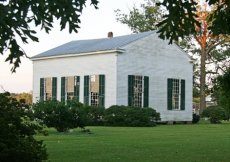Dates back to Skinnersville Chapel that served the community along the southern shore of the Albemarle Sound from 1785 to 1805. Special services are held periodically.
Rev. Charles Pettigrew, first bishop-elect of the Episcopal Church of North Carolina, served the old chapel twice a month during his ministry until the completion of his own Pettigrew Chapel in Creswell in 1805.
Skinnersville Chapel, was in very poor condition by 1803. Rev. Charles Pettigrew recommended that it be replaced. Swain’s Chapel, the second church was completed in 1805. These first two churches were interfaith chapels, until Swain’s Chapel was dedicated to the Protestant Methodist faith about 1828. When Swain’s Chapel was no longer useable, Joseph S. Norman, a local landowner, provided 7/8 acres of land on which Rehoboth Church was built in 1853. It is said that one of the benches in Rehoboth had come from Swain’s Chapel. Old Rehoboth records indicate that the new church was built a few hundred yards east of Swain’s Chapel. Miss Elizabeth White, named the church for a passage from the Bible: Genesis 26:22, “He, (Isaac), moved on from there and dug another well, and no one quarreled over it. He named it Rehoboth,[e] saying, “Now the LORD has given us room and we will flourish in the land.””
Heart pine and cypress for the construction of the church were cut from nearby woods. The slaves of the Norman brothers built the beautiful church that included a slave gallery, reached by a narrow, angular stairway, used by the slaves when they attended services. The floor in the slave balcony is slanted so those in the back could see the pulpit more easily.
The old road passed on the south side of the church, which has two doors – one door for men and the other door for women. The sanctuary is divided down the middle as well – one side for men and one side for women. There was a third door for the slaves to enter and exit. The view from the modern road, NC highway 32, on the north side of the building, is of the back of Rehoboth.
Rehoboth Church is very likely the third church that was built in this area of Washington County, NC. The 1733 Moseley Map shows a church on the shore of the Albemarle Sound between Kendrick’s Creek and, what is now, the end of the Albemarle Sound Bridge.
The county seat at Plymouth, 15 miles west of Rehoboth, was the site of Civil War battles in 1862 and 1864. Ultimately, only ten percent of the town survived at war’s end. Rehoboth, however, apparently remained untouched.
The grounds of Rehoboth serve as the final resting place of many past members of the church. Although several old tombstones remain, it is likely that many others rest there as well.
By 1965, the church had only seven members between the ages of 50 and 81. A booklet complied at the time succinctly captured their sentiments:
“They want their church to live after them.”
The local residents weathered slavery, the Civil War, Reconstruction, the Great Depression, World War I and II, storms, and hurricanes while never losing their faith in God. They enjoyed weddings, baptisms, dinner on the grounds, community meetings and funerals. Rehoboth Church was the rock in good times and bad. Through the years, many loyal citizens have served as stewards of this historic old church.












 Subscribe to RSS Feed
Subscribe to RSS Feed